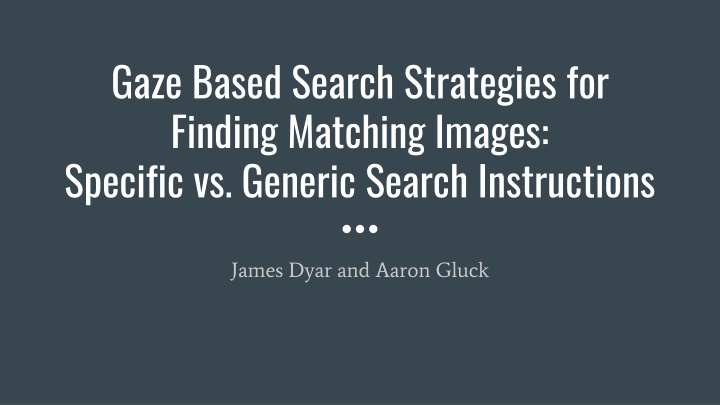
Visual Search Strategies: Specific vs. Generic Instructions in Eye Tracking Study
Explore the impact of specific vs. generic search instructions on visual search performance using eye tracking technology. The study involves participants matching images under different conditions and examines factors influencing image search efficiency. Results may offer insights into optimizing search tasks and enhancing visual perception techniques.
Download Presentation

Please find below an Image/Link to download the presentation.
The content on the website is provided AS IS for your information and personal use only. It may not be sold, licensed, or shared on other websites without obtaining consent from the author. If you encounter any issues during the download, it is possible that the publisher has removed the file from their server.
You are allowed to download the files provided on this website for personal or commercial use, subject to the condition that they are used lawfully. All files are the property of their respective owners.
The content on the website is provided AS IS for your information and personal use only. It may not be sold, licensed, or shared on other websites without obtaining consent from the author.
E N D
Presentation Transcript
Gaze Based Search Strategies for Finding Matching Images: Specific vs. Generic Search Instructions James Dyar and Aaron Gluck
Modifying Visual Search Patterns Task Dependency Yarbus, 1967 Affect eye movement and fixation by asking different questions Greene, 2006 Half of participants were told how to find the target image by using the visual distractors The Control of Fixation Duration in Visual Search Dr. Harold Greene http://journals.sagepub.com/doi/10.1068/p5329 They Did Not Expect Him. Ilya Repin. 1884-1888 https://commons.wikimedia.org/wiki/File:They_did_not_Expect_Him.jpg Introduction Introduction Methodology Methodology Results Results Discussion Discussion Conclusion Conclusion
Hypotheses H1: Participants given the specific search instruction condition will exhibit greater order of task performance as compared to the generic search instruction condition. H2: Participants will match images faster on full color trials than grayscale trials, and the search instruction condition moderates this effect. H3: Participants are more accurate at matching images on full color trials compared to grayscale trials. H4: Participants will learn that the target image s match for the full color trial and the grayscale trial is always in the same location. Introduction Introduction Methodology Methodology Results Results Discussion Discussion Conclusion Conclusion
Participants ID Age Gender Corrective Lenses Eye Eye Tracking Experience (1-10) Condition A01 25 F Glasses Strabismus 2 A02 51 F -- -- 1 A03 27 M -- -- 2 A04 27 M Glasses -- 6 A05 25 M -- -- 4 J01 21 F Glasses -- 1 J02 24 M Contacts Astigmatism 1 J03 21 F Contacts -- 1 J04 20 M -- -- 3 Methodology Methodology Introduction Introduction Results Results Discussion Discussion Conclusion Conclusion
Experimental Design Mixed Factorial Design: 2 x 2 Image color scheme (full color / grayscale) - within subjects - Counterbalanced x Search instruction (specific / generic) - between subjects Specific search instruction - Compare Generic search instruction - Find Methodology Methodology Introduction Introduction Results Results Discussion Discussion Conclusion Conclusion
Stimuli Methodology Methodology Introduction Introduction Results Results Discussion Discussion Conclusion Conclusion
Eye Tracking Gazepoint GP3 standalone eye tracker 60 Hz sampling rate 0.5 to 1 degree visual angle accuracy Pupil size tracking 50 to 80 cm operating distance Video-based pupil-corneal reflection Dell P2113t Monitor 22 monitor 1680 x 1050 screen resolution 60 Hz refresh rate Gazepoint GP3 Eye Tracker https://www.gazept.com/product/gazepoint-gp3-eye-tracker/ Methodology Methodology Introduction Introduction Results Results Discussion Discussion Conclusion Conclusion
Procedure IRB Consent Pre-experiment questionnaire Setup eye tracker, chin rest, and calibration Run experiment Participant is given one search instruction Find match of target image Compare images to target image to find match Five rounds of two trials Counterbalanced Full color Grayscale Found image? Stare at match and press spacebar Post-experiment questionnaire Methodology Methodology Introduction Introduction Results Results Discussion Discussion Conclusion Conclusion
Two-way ANOVA Wording has a significant effect on search time Medium effect size F(1) = 5.752, p = 0.018 Results Results Introduction Introduction Methodology Methodology Discussion Discussion Conclusion Conclusion
Chi-square test of independence Relationship between color and accuracy Effect on wording (compare / find) on accuracy ?2(1) = 0.5, p = 0.464 (n.s.) Effect on color (full color / grayscale) on accuracy ?2(1) = 7.2, p = 0.007 Results Results Introduction Introduction Methodology Methodology Discussion Discussion Conclusion Conclusion
Hypothesis 1 Compare Find Not supported Not supported Discussion Discussion Introduction Introduction Methodology Methodology Results Results Conclusion Conclusion
Hypothesis 2 Asked to COMPARE the target image to the other images to identify the matching image results in a longer search time. Asked to FIND the target image amongst the other images to identify the matching image results in a shorter search time. Wording has an effect on the time it takes to find the correct target image - Significant Supported Supported Discussion Discussion Introduction Introduction Methodology Methodology Results Results Conclusion Conclusion
Hypothesis 3 Post-experience questionnaire: 8 of 9 - Preferred finding match to full color target image 9 of 9 - Reported finding the full color match easier Participants more likely to find correct target image match for full color stimuli compared to grayscale stimuli - Significant Supported Supported Discussion Discussion Introduction Introduction Methodology Methodology Results Results Conclusion Conclusion
Hypothesis 4 Not supported Not supported Discussion Discussion Introduction Introduction Methodology Methodology Results Results Conclusion Conclusion
Explored the effect of task wording on search patterns. Participants were either asked to COMPARE the target image to the other images to find the match, or to FIND the target image s match. While search patterns based on task wording proved inconclusive, we believe that more explicit wording or removing the multiple stimuli could result in different findings. Conclusion Conclusion Introduction Introduction Methodology Methodology Results Results Discussion Discussion
Conclusion Conclusion Introduction Introduction Methodology Methodology Results Results Discussion Discussion
